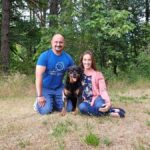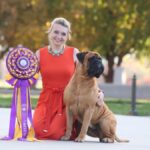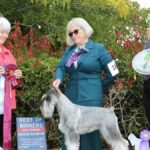Interview with Mary Remer | Banbury Bedrock Bull Terriers – AKC 2021 Breeder of the Year Terrier Group Honoree.
1. The Bull Terrier is an iconic breed with an unmistakable appeal. What is it about the breed that has sustained your interest for so long?
The Bull Terrier’s enduring sense of humor nourishes and sustains me. Their commitment to themselves makes the challenge. The ever-present question, “Can we do this together?” keeps me intrigued, present, and ever curious.
2. Breeding dogs requires the vision of an artist, the curiosity of a scientist, and the commitment of a philosopher. As a breeder, do you view yourself as an artist, a scientist or a philosopher? Maybe you are a combination of all three?
The breeder’s vision—to keep trying to produce to the breed standard—is a lifetime pursuit. Always, there is the curiosity, anticipation, and excitement of what could come from a mating now, and its impact on generations down the line. There are joys as well as devastations, which underscore the necessity of commitment. So, for me, it is a combination of the three.
3. In dogs, selection is key. How do you select your sire and dam combinations? How do you select which puppies will enjoy the spotlight of the show ring?
Selection for a breeding calls for rumination, and I am most fortunate to have mentors and co-owners/breeders to have lengthy discussions with. In the BT breed, there are three distinct types: Terrier, Dalmatian, and Bulldog. Each type exhibits distinguishable, prominent characteristics. These must be considered when planning a breeding. Sires and dams should complement each other. I am guided by Raymond Oppenheimer’s “20 Basic Breeding Principles.” I do not believe in taking chances with doubling up on faults. In this breed, a head can be put on in one generation, while compromising on construction can take a breeder a lifetime to resolve.
Genotype and phenotype both play critical roles. What does the pedigree bring to the table? Dominant masculine virtues are paramount in a stud dog. What virtues does the bitch exude? Prepotent producers give a feeling that grabs one. Temperament, type, health, and soundness of mind and body are essential. In our breed, bone, head quality, being short-coupled, and athleticism (demonstrated by correct angulation fore and aft) are mandatory.
Personally, I prefer when possible to breed coloreds to whites. I am always thinking forward to the future generations. While outcrossing can be useful, I believe linebreeding is the most constructive and yields the best result. That said, the BT gene pool is relatively small, so one must be mindful. We have a wonderful tool available now that provides an inbreeding coefficient, enabling the breeder to minimize inbreeding and its potential negative health consequences.
Puppies for the show ring are selected for their conformation and their “look at me” sparkle. They have to say, “Bull Terrier.”
4. The breed standard is the preservation breeder’s most essential tool. What are your thoughts on the importance of breeding to the standard and presenting the breed in the ring accordingly?
I believe in breeding to the standard—that’s why we have it. I think our standard could benefit from more specification. For instance, the standard says the Bull Terrier should “move compactly… with a typical jaunty air that suggests agility and power.” It does not, however, provide more specificity regarding size. When I started in the breed, our dogs were 65 to70 pounds and bitches were 45 to 50 pounds. We have seemingly moved to “bigger is better”—which can result in losing type. Additionally, managing an 80-pound Bull Terrier is a daunting task. Our breed is to be athletic, and this would be difficult at that weight.
5. Today’s breeders have found themselves on the defensive from public criticism and from legislative proposals that would restrict breeding practices. In your opinion, what can preservation breeders do to counter the anti-purebred rhetoric that has taken hold in this country?
I think, as preservation breeders, we must work hard to keep our dogs in the public eye. It’s important for the public to have available educational opportunities about and exposure to individual breeds. This helps potential owners find the breed that is best suited to them, their family, and their lifestyle. The Meet the Breeds venues are terrific, and the ones that I have been to have been very well-attended. As responsible breeders, we need to be accessible mentors. We need to speak to the importance of genetic testing, health screenings, and temperament testing. We must be committed to being ethical guardians, to producing healthy, well-socialized puppies, and to educate, educate, educate the public as to the benefits of owning a responsibly bred and raised purebred dog.
Interview with Mary Remer | Banbury Bedrock Bull Terriers, featured image from http://www.banburybedrock.com/









